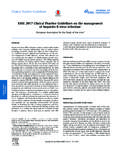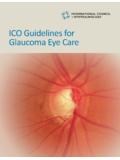Transcription of EASL Recommendations on Treatment of Hepatitis …
1 1 JOURNAL OFHEPATOLOGYSEPTEMBER 2016 EASL Recommendations on Treatment of Hepatitis C 2016 SUMMARYE uropean Association for the Study of the LiverEASL Office7 rue Daubin, 1203 Geneva, SwitzerlandTel: (+41) 22 807 03 67 Fax: (+41) 22510 24 00e-mail: Pawlotsky Francesco Negro (EASL governing board) Alessio Aghemo David Back Geoffrey DusheikoXavier Forns Massimo Puoti Christoph SarrazinCoordinator:Panel members:Contents1. Diagnosis of acute and chronic Hepatitis C2. Screening for chronic Hepatitis C3. Goals and endpoints of HCV therapy4. Pre-therapeutic Search for other causes of liver Assessment of liver disease HCV RNA or HCV core antigen HCV genotype HCV resistance testing5. Contraindications to therapy6. Indications for Treatment : who should be treated?7. Available drugs in the European Union in Sofosbuvir and Sofosbuvir and Ritonavir-boosted paritaprevir, ombitasvir and Grazoprevir and Ribavirin8.
2 Treatment of chronic Hepatitis C, including patients without cirrhosis and patients with compensated (Child-Pugh A) Treatment of HCV genotype 1 Treatment of HCV genotype 2 Treatment of HCV genotype 3 Treatment of HCV genotype 4 Treatment of HCV genotype 5 or 6 infection9. Treatment of patients with severe liver disease with or without an indication for liver transplantation and patients in the post-liver transplant Patients with decompensated cirrhosis, no HCC, with an indication for liver Patients with HCC, without or with compensated or decompensated cirrhosis, with an indication for liver Post-liver transplantation Patients with decompensated cirrhosis without an indication for liver Patients with HCC without an indication for liver transplantation10. Treatment of special HBV Immune complex-mediated manifestations of chronic Hepatitis Patients with Patients with renal impairment, including haemodialysis Non-hepatic solid organ transplant Active drug addicts and patients on stable maintenance Bleeding disorders311.
3 Treatment Monitoring of Treatment Monitoring of Treatment Sofosbuvir and Sofosbuvir and Ritonavir-boosted paritaprevir, ombitasvir and Grazoprevir and Monitoring of drug-drug Treatment dose reductions12. Measures to improve Treatment adherence13. Post- Treatment follow-up of patients who achieve SVR14. Retreatment of non-sustained virological Retreatment of patients who failed after a double combination of pegylated IFN- and Retreatment of genotype 1 patients who failed after a triple combination of pegylated IFN- , ribavirin, and telaprevir, boceprevir or Retreatment of patients who failed after an IFN-free regimen (all genotypes)15. Follow-up of untreated patients and of patients with Treatment failure16. Treatment of acute Hepatitis C17. Perspective of new treatments4 MethodologyThese EASL Recommendations have been prepared by a panel of experts chosen by the EASL Governing Board.
4 The Recommendations were approved by the EASL Governing Board. The Recommendations have been based as far as possible on evidence from existing publications and presentations at international meetings, and, if evidence was unavailable, the experts personal experiences and opinion. Wherever possible, the level of evidence and recommendation are cited. The evidence and Recommendations have been graded according to the Grading of Recommendations Assessment, Development and Evaluation (GRADE) system. The strength of Recommendations thus reflects the quality of underlying evidence. The principles of the GRADE system have been enunciated [7]. The quality of the evidence in the Recommendations has been classified into one of three levels: high (A), moderate (B) or low (C). The GRADE system offers two grades of recommendation: strong (1) or weak (2) (Table 1).
5 The Recommendations thus consider the quality of evidence: the higher the quality of evidence, the more likely a strong recommendation is warranted; the greater the variability in values and preferences, or the greater the uncertainty, the more likely a weaker recommendation is Recommendations are necessarily based on currently licensed drugs. They will be updated regularly, following approval of new drug regimens by the European Medicines Agency and other national European agencies. 1. Diagnosis of acute and chronic Hepatitis C Anti-HCV antibodies are the first line diagnostic test for HCV infection (A1). In the case of suspected acute Hepatitis C or in immunocompromised patients, HCV RNA testing should be part of the initial evaluation (A1). If anti-HCV antibodies are detected, HCV RNA should be determined by a sensitive molecular method (A1). Anti-HCV positive, HCV RNA-negative individuals should be retested for HCV RNA 3 months later to confirm definitive clearance (A1).
6 HCV core antigen is a surrogate marker of HCV replication and can be used instead of HCV RNA to diagnose acute or chronic infection when HCV RNA assays are not available or not affordable (core antigen assays are slightly less sensitive than HCV RNA assays for detection of viral replication) (A1).2. Screening for chronic Hepatitis C Screening strategies for HCV infection should be defined according to the local epidemiology of HCV infection, ideally within the framework of national plans (A1). Screening for HCV infection is presently based on the detection of anti-HCV antibodies (A1). Whole blood sampled on dried blood spots can be used as an alternative to serum or plasma obtained by venipuncture (A1). Rapid diagnostic tests using serum plasma, fingerstick whole blood or crevicular fluid (saliva) as matrices can be used instead of classical enzyme immunoassays to facilitate anti-HCV antibody screening and improve access to care (A1).
7 If anti-HCV antibodies are detected, HCV RNA, or alternatively HCV core antigen if HCV RNA assays are not available or not affordable, should be determined to identify patients with on-going infection (A1).3. Goals and endpoints of HCV therapy The goal of therapy is to cure HCV infection to prevent hepatic cirrhosis, decompensation of cirrhosis, HCC, severe extrahepatic manifestations and death (A1). The endpoint of therapy is undetectable HCV RNA in blood by a sensitive assay (lower limit of detection 15 IU/ml) 12 weeks (SVR12) and/or 24 weeks (SVR24) after the end of Treatment (A1). Undetectable HCV core antigen 12 weeks (SVR12) and/or 24 weeks (SVR24) after the end of Treatment is an alternative endpoint of therapy in patients with detectable HCV core antigen prior to therapy if HCV RNA assays are not available or not affordable (A1). In patients with advanced fibrosis and cirrhosis, HCV eradication reduces the rate of decompensation and will reduce, albeit not abolish, the risk of HCC.
8 In these patients surveillance for HCC should be continued (A1). 4. Pre-therapeutic Search for other causes of liver Assessment of liver disease severity The causal relationship between HCV infection and liver disease should be established (A1). The contribution of comorbid conditions to the progression of liver disease must be evaluated and appropriate corrective measures implemented (A1). Liver disease severity should be assessed prior to therapy. Identifying patients with cirrhosis is of particular importance, as their Treatment regimen and post- Treatment surveillance must be adapted (A1). Fibrosis stage can be assessed by non-invasive methods initially, with liver biopsy reserved for cases where there is uncertainty or potential additional aetiologies (A1). Cardiac and renal function should be ascertained (A1). HCV RNA or HCV core antigen detection/quantification HCV genotype determination HCV resistance testing HCV RNA detection and quantification should be made by a sensitive assay with a lower limit of detection of 15 IU/ml (A1).
9 If HCV RNA testing is not available or not affordable, HCV core antigen detection and quantification by EIA can be used as a surrogate marker of HCV replication (A1). The HCV genotype and genotype 1 subtype (1a or 1b) must be assessed prior to Treatment initiation and will determine the choice of therapy, among other parameters (A1). Systematic testing for HCV resistance prior to Treatment is not recommended. Indeed, this obligation would seriously limit access to care and Treatment regimens can be optimized without this information (B1). Physicians who have easy access to a reliable test assessing HCV resistance to NS5A inhibitors (spanning amino acids 24 to 93) can use these results to guide their decisions, as specified in these Recommendations . The test should be based on population sequencing (reporting RASs as present or absent ) or deep sequencing with a cut-off of 15% (only RASs that are present in more than 15% of the sequences generated must be considered) (B1).
10 55. Contraindications to therapy 6. Indications for Treatment : who should be treated? All Treatment -na ve and Treatment -experienced patients with compensated or decompensated chronic liver disease due to HCV must be considered for therapy (A1). Treatment should be considered without delay in patients with significant fibrosis or cirrhosis (METAVIR score F2, F3 or F4), including decompensated (Child-Pugh B or C) cirrhosis, in patients with clinically significant extra-hepatic manifestations ( symptomatic vasculitis associated with HCV-related mixed cryoglobulinaemia, HCV immune complex-related nephropathy and non-Hodgkin B cell lymphoma), in patients with HCV recurrence after liver transplantation, and in individuals at risk of transmitting HCV (active injection drug users, men who have sex with men with high-risk sexual practices, women of child-bearing age who wish to get pregnant, haemodialysis patients, incarcerated individuals) (A1).















